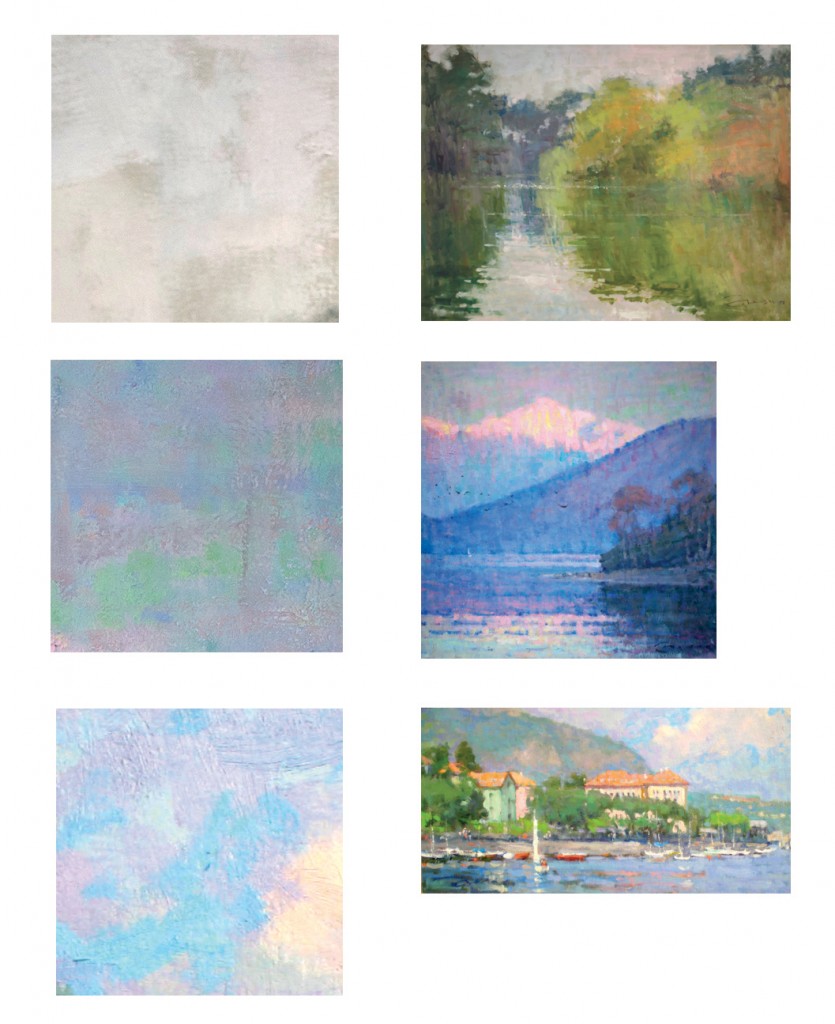Language And The Art Of Seeing
A requirement of Impressionist painting is to have a thrilling experience as we see. But there is a big barrier that tends to block the thrill: our language. That is, we picture the world through the language we speak. In fact, we often don’t really see the world around us at all. Instead, what we see most often is our expectation.
For example, if I ask you to think of a color when I say the word “apple,” you will say “red.” And “grass?” You will say “green.” What about “sky?” “Blue,” of course. What’s the problem?
Well, okay, let’s take a look. On the left is an image of a blue sky.


If this is my concept of what “sky” is, it is likely that the color to the right (a “sky” blue) will find its way into whatever sky I actually see. In other words, the very concept of sky – that is, blue – tends to displace the sensation of color that enters my eyes.
Monet was well aware of this problem. He once said to a friend that he wished he had been born blind and then had suddenly gained his sight so that he could have begun to paint without knowing what the objects were that he saw before him. Monet is telling us that it is necessary to step out of our language. That we ought not to see “sky” when we look at the sky. This is quite difficult but seeing this way becomes a bit easier if we also follow Monet’s advice:
“When you go out to paint try to forget what object you have before you – a tree, a house, a field or whatever. Merely think, here is a little square of blue, here an oblong of pink, here a streak of yellow, and paint it just as it looks to you, the exact color and shape, until it emerges as your own naive impression of the scene before you.”
This is what I tried to do in the examples below. The squares on the left are patches of sky taken from the paintings on the right.

You will notice that in the first example there is no significant amount of blue. In the second example you will see that there is a fair amount of green. And in the third, which is a “blue sky” with puffy “white” clouds, there are several colors which modify the blue and there is no white.
Here’s the point: to be free to see with our eyes, we must let go of the shared set of ideas and distinctions that are part of our received way of life that congeal into a language. We must be free not only of descriptive terms like sky or boat or house, we must be free of other concepts that are part of our entire self-understanding as we stand there with brush in hand – such as the concepts of art, painting, talent, work, success, and many more.
It is ironic that the academic cognoscenti today dismiss Impressionism as little more than “eye candy,” hardly “challenging” or “difficult” at all. It would also behoove us to get free, as did the Impressionists, from such concepts as “expert,” “director,” “juror,” “awards,” and “hierarchy” as well.
4 Comments
Address
Via Teresio Olivelli, 20
22021 Bellagio (CO)
Italy
+39 338 975 7135
Open Hours
Tuesday - Saturday: 11:00am – 6:00pm
Sunday - Monday: 1:00pm – 6:00pm

I am forwarding this article to my class of regular students. I hope they hear an echo in the room when they read it and benefit from hearing a similar message in someone else’s language and visual references. Just as language and labelling tends to inhibit right-brain functioning, language confuses and interferes with perception and understanding. All artists would do well to consider this concept to avoid falling into the rabbithole of iconic visualization and literal representation. I love Monet’s suggestion on how to “see” what is in front of us. I am sure my students perceive me with these warnings imprinted on my forehead: Don’t be so literal. Don’t tell the whole story. Think in terms of the elements of design…..such as line and color.
All good principles bear repeating. Thank you for doing so so succinctly in your article.
I’m almost ashamed to list my website here as there is very little evidence of Jerry’s teachings on it.
According to Napoleon Hill, procrastination is one of the greatest causes of failure. I’m guilty. I have yet to buy new canvasses/boards specifically for this method of painting as I have felt I needed to work my way through a stack of art material accumulated over half a lifetime. I know – shocking!
Result? I will have to wend my way to Lake Como for a third session with The Master in order to refresh my memory and, well, many other reasons. Conchitina’s food, for one thing! So, be warned, Jerry.
I do love your work!
Hi Maria – My teacher always used to say, “At some point take ‘the method,’ throw it out the window and find yourself.” His point (which I fully agree with) is that the
method he taught, and which I now teach, is little more than a springboard or maybe a set of training wheels. The intention, and this is really the crux of
Impressionism, is for each of us to find our own voice and sing – mightily and fearlessly. Independence is the watchword. Now, “the method,” given that it is
solid and the distillation of hundreds of years of painting knowledge, ought not to be discarded simply because one wishes to spread his or her wings. I think we need to spend a bit of time with it and get to know it. I wouldn’t throw it out the window until I have thoroughly worn it out. I’m not there yet. Long story short, no need to find me in your work. Procrastination? Well, puttering around, at times, is part of the creative process. Only you know if it is really procrastination. But I would keep in mind that if it is fear that is holding you back, the results aren’t the important thing. The measure of a painting is always the feelings you have as you make it – not unlike so many of life’s activities. If you are moved, it is not possible to fail or fear. Get to the feelings and the rest will follow.
Jerry,
Thank you for addressing this very issue that has hindered me in my painting in the past. Seeing an object through language, and not as color, or shape, (fear of the ‘apple’ or ‘grass’ – getting it as it appears) thus, frustration. Only lately have I found that one must as you say, see shape, color, temperature as units in a whole. Since looking at this in that standpoint, I have begun to really enjoy painting for what it is, an expression of one’s self through feeling, color, shape, line, and not worrying about the ‘red’ apple, ‘green’ grass, etc. Living in Cincinnati, Ohio, USA, it is almost impossible to participate in a workshop, but your videos and this newsletter, is the next best thing!